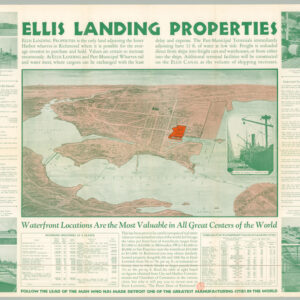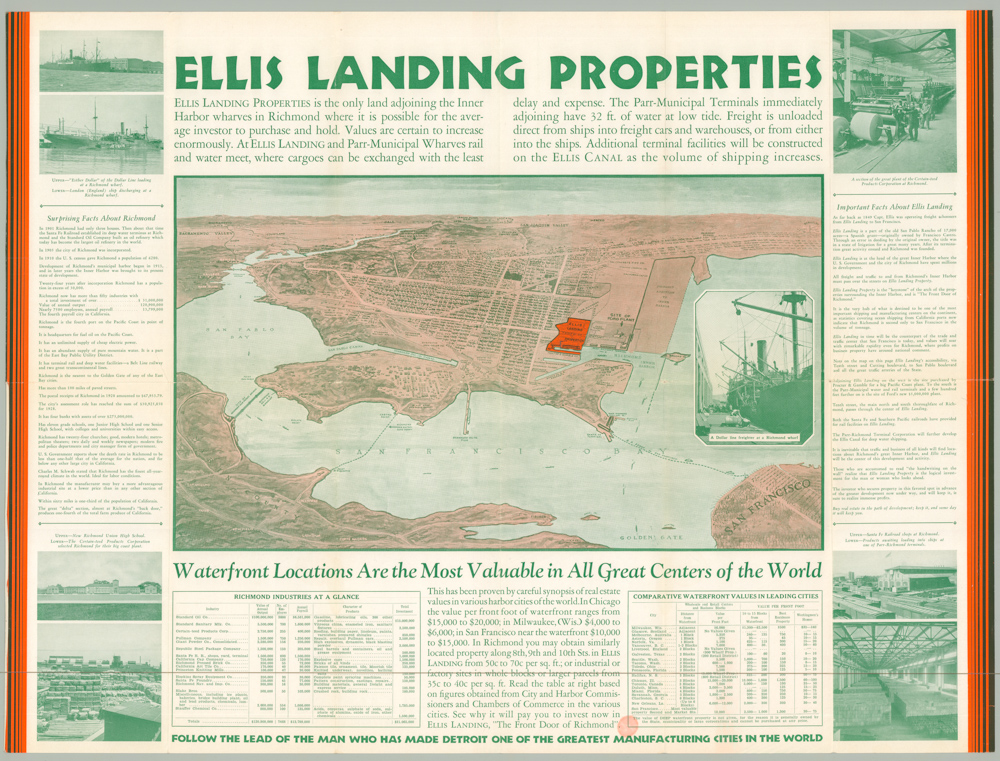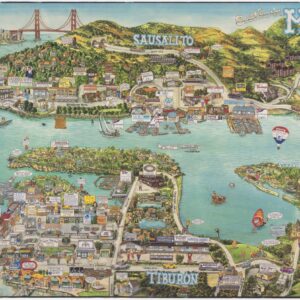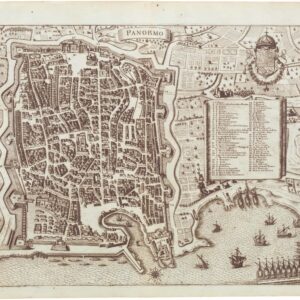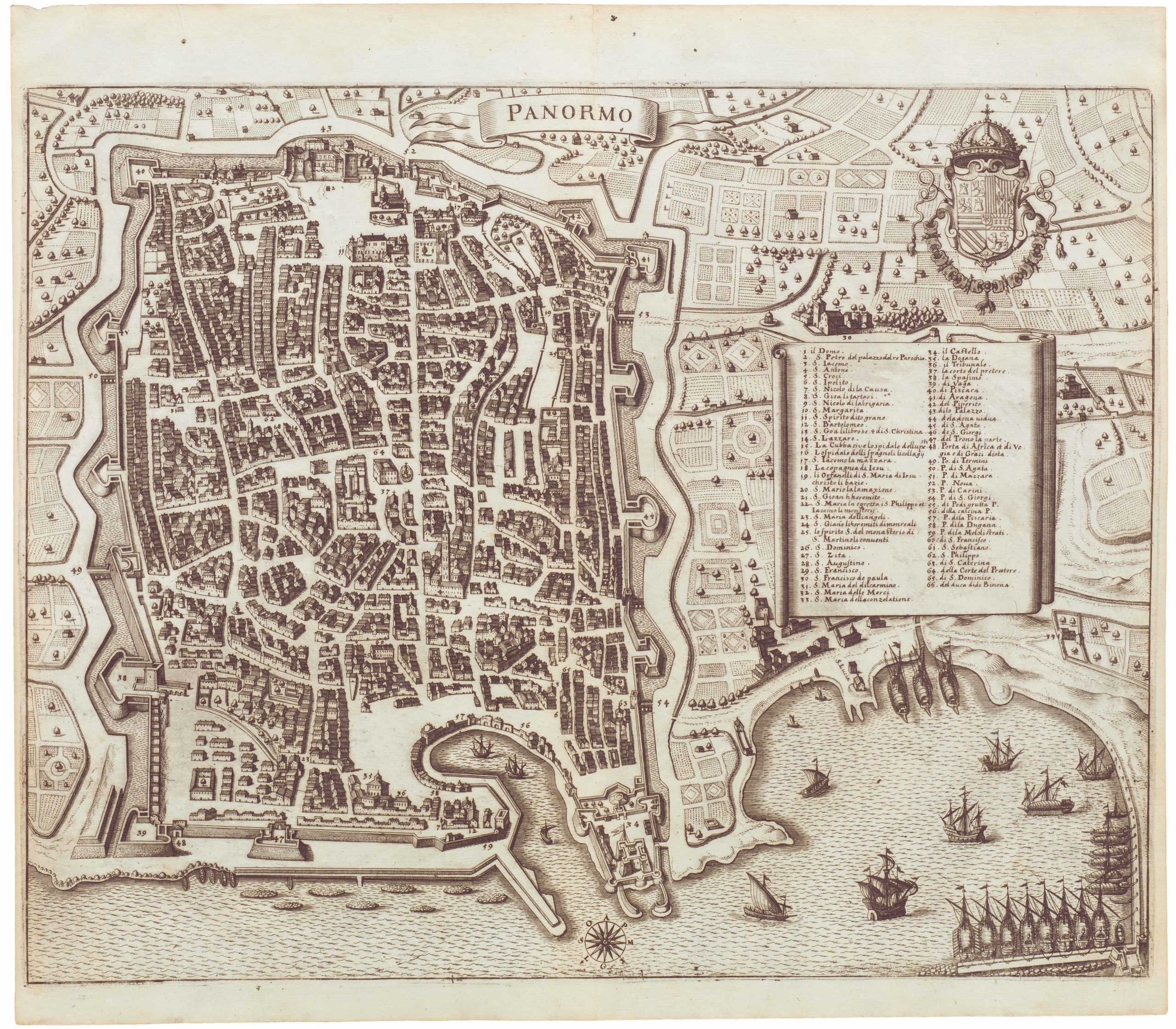An Exceedingly Rare Early Gold Rush View of San Francisco. One of Three Known Examples in Full Original Hand Color, Finished With Gouache.
San-Francisco, Vue prise d’un point elevé du côté Sud
Out of stock
Description
From the First Generation of San Francisco Viewmaking — Possibly The Earliest Gold Rush Era View of the City Printed in Europe.
An exquisite example of Le Breton’s fine and decorative view of San Francisco from the south, quite possibly the earliest view of the city from such an angle.
Published in 1850 in Paris, the view shows San Francisco at some point between 1848 and mid-1850. The view can be dated based upon the presence of Central Wharf (also known as Long Wharf — first built in the spring of 1848 and extending 800 feet into San Francisco Bay), but prior to the extension of the wharf by an additional 1,200 feet in 1850.
The view captures the rugged nature of San Francisco during the earliest days of the gold rush. Taken from Rincon Hill, the city is framed by Russian Hill on the left and Telegraph Hill on the right. Telegraph Hill is particularly difficult to recognize for the modern-day viewer, as it has since been leveled off. The two hills neatly frame the Marin Peninsula, providing the earliest known view of the future Marin County area.
At the right, the view opens to the waters of San Francisco Bay. The abundant maritime activity speaks to the city’s booming role as one of the major trading sea ports for the gold regions of California, including the enormous wharf at the center. Further north, some ships appear to bypass San Francisco fully in search of the San Pablo Bay, the Carquinez Straits, and closer proximity to the gold regions.
Onshore, the rapid growth of San Francisco is clearly depicted. Houses have already saturated the flatlands near the wharf and begun to creep up the sides of Telegraph Hill and Russian Hill. Canvas teepees dot the landscape, depicting the prevalence of these tent encampments in the early days of San Francisco. Around Rincon Hill, trees dot the landscape, explaining why the neighborhood was originally known as woodlands.
Louis Le Breton was a surgeon in the French Navy between 1836 and 1848. His work was later exhibited in Paris. While it is unclear whether he was in California in 1848 or 1849, the quality and accuracy of the view, and its unique perspective, clearly demonstrate that the work was created from original artwork drawn on the spot by a skilled artist sometime between the second half of 1848 and early 1850, early enough to have been transmitted back to Paris and to have appeared in print by 1849 or 1850.
A History of Early San Francisco Views
Le Breton’s view is one of the earliest first generation of San Francisco views and likely the earliest view of San Francisco from the South. While Reid Dennis (Stanford copy) has dated the view as circa 1848, this seems unlikely. Reps dates the view to circa 1850. The view was advertised for sale in the in the December 7, 1850 issue of the Bibliographie de la France, ou, Journal général de l’imprimerie et de la librairie, suggesting a publication date of late 1849 or 1850.
In varying sizes and states, Reps identifies four surviving views of San Francisco published in 1849. These include Prevost (in New York), Baker (in New York), Firks (in New York), and Hutchins (in Liverpool). Reps notes an additional eight views in 1850, with only this view and the much smaller Duval/Kuchel view drawn from the south.
An Early View of Marin
One of the many interesting aspects of the view is the alpine nature of Marin County. The mountains to the northwest are massively exaggerated in stature, but this should not detract from the importance that the view has in portraying Marin.
As most views of San Francisco from the time were taken from the harbor, rather than from land, they did not capture Marin in the background. As such, this is likely the earliest printed view of Angel Island and Richardson Bay, where Sausalito, Tiburon, and Belvedere are located.
States
Reps identifies 4 states of the view from 1850:
- Title reads “San-Francisco, Vue Prise d’un point élevé du côte Sud. Two additional engraved imprints in lower left and lower right below title. Printer “Auguste Bry 149, r du Bac. Paris”. Publisher “E. Savarie et Cie, Paris and E. Gambart and Co., Lonon”.
- (Californie) added to title. Imprints still present in corners. Printer “Auguste Bry 149, r du Bac. Paris”. Publisher “E. Savarie et Cie, Paris and E. Gambart and Co., London”.
- Imprints in lower left and lower right corners removed. Printer “Auguste Bry, 114,r. du Bac, Paris”. Publisher “Wild, Editeur, 15, rue de la Banque Place de la Bourse, Paris”.
- Printer changed. Publisher removed. Printer “F. Appel, 12, rue de Delta, Paris”.
Rarity
Reps identifies 5 surviving examples of the view in the early states:
- Yale University Art Gallery (State 1, uncolored, state 3, colored)
- Robert B. Honeyman Collection, Bancroft Library (state 2, colored)
- Reid W. Dennis Collection, Stanford University (state 2, partially colored)
- Amon Carter Museum (state 4, uncolored)
Cartographer(s):
Louis Le Breton (1818-1866) was a French painter who specialized in landscapes and maritime themes. Le Breton studied medicine and later served as a doctor in the French Navy. He was a crew member on Dumont d’Urville’s second voyage aboard the Astrolabe. During the expedition, the official illustrator perished. Le Breton was named his replacement and earned some renown in this role.
From 1847, he spent most of his time composing paintings of marine subjects for the French Navy. In the early 1860s, he created 69 illustrations of occult demons for the 1863 edition of Dictionnaire Infernal by Collin de Plancy.
Condition Description
Lithograph with original hand-color, finished with gouache. Even toning. Minor dampstain to base.
References
Reps 256; Baird & Evans 74c.
![[Pair of views] Rade et Ville de Sincapour & Rade de Sincapour prise de la maison du Gouverneur](https://neatlinemaps.com/wp-content/uploads/2021/03/NL-00896-harbor_Thumbnail-300x300.jpg)
![[Pair of views] Rade et Ville de Sincapour & Rade de Sincapour prise de la maison du Gouverneur](https://neatlinemaps.com/wp-content/uploads/2021/03/NL-00896-harbor_Thumbnail.jpg)
